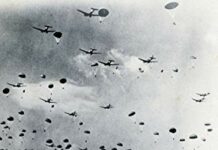
Ebook Info
- Published: 2049
- Number of pages: 644 pages
- Format: PDF
- File Size: 4.40 MB
- Authors: Antony Beevor
Description
“Glorious, horrifying…D-Day is a vibrant work of history that honors the sacrifice of tens of thousands of men and women.”—TimeBeevor’s Ardennes 1944: The Battle of the Bulge is now available from Viking Books Renowned historian Antony Beevor, the man who “single-handedly transformed the reputation of military history” (The Guardian) presents the first major account in more than twenty years of the Normandy invasion and the liberation of Paris. This is the first book to describe not only the experiences of the American, British, Canadian, and German soldiers, but also the terrible suffering of the French caught up in the fighting. Beevor draws upon his research in more than thirty archives in six countries, going back to original accounts and interviews conducted by combat historians just after the action. D-Day is the consummate account of the invasion and the ferocious offensive that led to Paris’s liberation.
User’s Reviews
Reviews from Amazon users which were colected at the time this book was published on the website:
⭐As the title of this review suggests, I was drawn to Antony Beevor’s book “D-Day: The Battle for Normandy” because the book’s title promises to focus not just on June 6, 1944, but also on the succeeding weeks of desperate close-quarters fighting in the hinterlands of the Normandy beachhead. In this regard, Beevor’s book does not disappoint.Most people know that the June 1944 Normandy landings were a huge gamble that could have gone badly (indeed, Eisenhower, supreme Allied commander in Europe and the one who gave the go-ahead for the D-Day landings on June 6, had prepared a short speech to be delivered in the very real event that the American, British, and Canadian armies failed to establish a beachhead), and the actual D-Day landings at Utah, Omaha, Gold, Juno, and Sword beaches have been covered in the most minute detail (by Cornelius Ryan, Max Hastings, and others)in the last 65 years. As important as getting a toehold on these beaches was in the first few days (and as fantastic a logistic feat the June landings were), the great majority of the battles (and casualties)occurred in the next two months as the Allied and German armies clashed in the most bitter fighting in the hedgerow (“bocage”) and hill country just inland of the beaches. Gains and losses in these battles were often measured in hundreds of yards, while the British and American casualty-rates were double those of the Soviet forces (2000 losses per division per month in the West, as opposed to 1000 per division on the Eastern Front) in the comparable timeframe, even as the Soviet armies were rolling the Germans back hundreds of miles in their massive Operation Bagration offensive.I began Beevor’s book particularly interested in the numerous and successive British offensives in the seemingly compact eastern sector of the Allied front (Operations Epsom, Goodwood, and Totalize) that appeared to be signal failures despite the massive human and materiel resources (including hundreds of RAF and USAAF bombers that carpet-bombed the frontlines prior to Goodwood and Totalize) and where gains were maybe a few miles at best at the cost of hundreds of tanks and thousands of men. As with all his battle-coverage, Beevor is excellent at narrating these desultory battles in adequate detail (including identifying the units on both sides) without getting bogged-down in any kind of rote recitation. (Also, a major virtue of this book, as with all of Beevor’s titles I have read, is the superb maps.) In Epsom, Goodwood, and Totalize, Gen. Montgomery always promised a major breakthrough, only to (characteristically, of course) seek to shift the blame to other Allied commanders when these operations failed to meet their most modest goals. After five years of war, the British were at the end of their materiel and manpower reserves; they had failed to take enough territory inland of the Gold, Juno, and Sword beaches to build airfields for tactical fighter support; they were facing the majority of SS divisions on the Normandy front along a very short frontline; their Churchill and Cromwell tanks were far inferior to German tanks; the hedgerow and hill country of Normandy severely limited armored mobility and thus favored the defending Germans who also had large numbers of 88mm flak guns to kill Allied tanks; and it did not help that the heavy Allied bombers which were supposed to tear open the German frontlines prior to Goodwood and Totalize, made their bombing-runs perpendicular to the frontline rather than flying parallel to the front (in an effort to limit exposure to the many German flak batteries) and ended up hitting almost as many Allied ground forces as German troops.To the west, the Americans faced the same difficulties in terms of limited mobility in the hedgerows (one American officer who had served in the Pacific compared bocage fighting to jungle warfare), superior German tanks and 88s, and fanatical resistance by German troops convinced that failure to push the Western Allies off the northern continent meant the inevitable end of the Reich. And it would be unfair to say the Americans initially fared much better than the British and Canadians, when U.S. troops were trapped in the hedgerows for a month after D-Day. However, the American forces were able to secure more territory (aided by airborne landings and paratroopers) inland of the beaches immediately after D-Day and were thus able to build fighter airfields within their beachheads; were successful in driving across the Contentin Peninsula to the Atlantic and the approaches to Brittany, and reducing the German forces northward and eventually capturing the port of Cherbourg; and, crucially, the Americans had vastly more manpower and materiel resources than the British.As the British sector of the Normandy front bogged-down, and gains were measured in increments of five miles, Montgomery (conveniently) declared that his forces’ function was now to tie-down the majority of the SS units in the eastern sector so that the Americans could achieve a breakout further west around the left flank of the German forces in Normandy. This indeed did occur in Operation Cobra, 25 July-1 August, 1944. When a Soviet general observing the stalemated British sector commented to a British general that Soviet forces faced many more German troops on the Eastern Front than the Allied forces faced in Normandy, the British commander retorted that the Russians faced the same number of German soldiers across many hundreds of miles of front in the East that the Americans and especially the British faced along a front of all of sixty miles. Again, Beevor rightly observes that (for a change) the fighting in Normandy was more ferocious than in the comparable period in the East. There is much truth in this observation.Beevor also gives substantial coverage to the defending German forces in Normandy. These included both regular Wehrmacht army as well as many SS units, including both SS panzer corps and Hitler Youth divisions. While the Germans fought doggedly, often to the last man, inflicted heavy losses on the Americans and British for every mile gained, and specialized in quick and punishing counterattacks, I was struck, in reading Beevor’s book, at the horrendous losses the Germans were suffering from the very beginning of the Normandy battles. The Germans had negligible air support for the duration of the fighting, and they were consequently pummeled by British and American fighters every daylight hour of every clear day. The reader very quickly appreciates how difficult these constant air attacks made it for German operations. Rommel (the German commander in Normandy in the early days after June 6) had been promised generous Luftwaffe aid in the event of any Allied landings, and when this air support did not materialize (there were not enough planes, pilots, or fuel), he quickly realized that (as he had experienced in North Africa) it was basically futile to try to throw the Allies back into the sea. The German mechanized forces (and even reserves of ground troops marching to the front from deeper inside France) could move only at night and had to remain hidden during the day. Though German troops were experienced and determined, they and their commanders quickly learned that this was no way to conduct a successful military campaign. This eventually culminated in late August 1944 in the slaughter from the air of tens of thousands of German troops in the Falaise Pocket when Allied forces decisively broke out and sent German armies reeling all the way back to Paris and the line of the Seine. However, even here it should be said that determined German resistance coupled with inept British /Canadian leadership, allowed many German troops to escape the Falaise Packet and subsequently be deployed against the Allies in the Ardennes in December 1944, and in Hungary in March 1945, in the last two German offensives of the war.This is the third book by Antony Beevor that I have read (I have also read his book on the British defeat in Crete in 1941, and his “The Fall of Berlin” on the final German defeat in 1945), and I greatly enjoyed it. Beevor is clearly immersed in the primary (he researched in the relevant archives in North America and Europe) and secondary literature, yet his prose is not turgid or overly technical. He writes in a clear and effective style in which the reader feels Beevor gives his subjects a complete treatment with a certain economy of words. There are also fascinating single chapters on the July 20, 1944, assassination attempt on Hitler, and the liberation of Paris, that offer brief but masterly accounts of these more peripheral events.
⭐[Expletive deleted], Beevor is a good writer. How I envy him. His recounting of Stalingrad got into the dirty details, both at the top and lower echelons. I admire him not just for the research that went into this book, and not just for his ability to write in such a way that the readers attention is in the thrall of that prose, but because of Beevor’s even handedness. He treats the Allies, the Germans, and the French will equal candor.The ability to “take the role of the other,” as a sociologist described it, may seem like a small thing. Anybody can do it. Yet even military historians have shown a lack of that ability.The late Stephen Ambrose did a book on D-Day too, noting that the French civilians of Normandy and Brittany were more sullen that the civilians of the South. He offered no explanation and left us with the assumption that there are regional differences in national character.But the fact is that the French civilians of northern France had plenty of reasons to be resentful, as well as many reasons to be grateful. Except for the French resistance (made up of fractious elements, much like the Syrian insurgents today), the French had lived in reasonable comfort among the Germans, whose orders regarding public behavior were strictly enforced. And, after all, we had just bombed the hell out of Normandy. The critical city of Caen had been literally flattened by bombs and artillery to no particular tactical advantage. Crops were devastated and the fields dotted with the rotting carcases of cows.And by the time the Allies reached Paris — well, let me quote Beevor.”The Petit Palais had been taken over, with a large sign announcing the distribution of free condoms to U.S. troops. In Pigalle, rapidly dubbed ‘Pig Alley’ by GIs, prostitutes were coping with over 10,000 men a day. The French were also deeply shocked to see U.S. Army soldiers lying drunk on the pavements of the Place Vendôme. The contrast with off-duty German troops, who had been forbidden to even smoke in the street, could hardly have been greater.”Separate chapters are given over to the attempt to assassinate Hitler and to the liberation of Paris. That second one, the liberation, would have been hilarious if it hadn’t been so serious and at times lethal. You have the U.S. Army arguing with the organized and uniformed French troops for the honor of being the first to enter Paris. Then you had the French generals, LeClerc and DeGaulle, arguing with each other. Then you had the civilian French resistance arguing with the uniformed French army. Then you had the leaders of the factions within the resistance — the nationalists, the communists, the marginal groups — arguing with each other. Although in retrospect it may seem unlikely, DeGaulle was the most steady and reasonable figure. That will give you some idea of how complicated this strictly symbolic issue was.I won’t go on about it. Most other reviewers have hit the high spots of the book and of Beevor’s writing skills. Beevor knows what he’s talking about and he tells the story well.
⭐…at least that’s what you would believe if this was your only reference to this pivotal event in world history – although Hemingway did lend a hand. Montgomery must have really upset Antony Beevor, because he takes every opportunity to paint him in such an unfavourable light that it’s hard to believe he made it to the end of the war above the rank of private.I finished the thinking I new need to find a more objective history – the only saving grace was that I only paid 99p!One last irritation, during the occupation he refers constantly to Milo mindbenders, a reference to catch 22 apparently, Antony,just say black marketeers.
⭐The book starts well but then falls down when comparing American leadership with the British. I’m sure it’s true but when he discusses American failures he glosses over them and yet when dealing with British failures there is a general criticism that at times seems totally out of step with the rest of the book. This criticism rises through the book with the use of hearsay in support of the American role and no attempt to discuss the British one. The majority of sources he has used are American which may explain why he has written it in this jaundiced and prejudicial style.
⭐Interesting subject, but very poorly executed. The author makes you believe that it was only the Americans who won the war with minimum help from the rest of the allied troops, the author was also quick to point out the failures of the British Army whilst constantly praising the Americans. All of the allied powers made mistakes not just the British forces. With the author being British you’d of thought he’d write more about his own country’s part in the war not just the American
⭐I should start by saying that I am a great admirer of Sir Antony Beevor and have over ten of his books in my study. However, although a bit like the curate’s egg [“Parts of it are excellent”], ‘D-Day’ left me disappointed. I suppose that Beevor had to start somewhere but any account of OVERLORD which effectively omits the months and years of detailed planning that went into the naval and military operations was bound to do so. The fact that Lieutenant General Freddie Morgan only merits a single mention (and Vice-Admiral Bertram Ramsay a bare handful) simply ignores the tremendous effort that they (and their respective staffs) put into making OVERLORD a success.For me, a significant criticism of the book arose within the first few Chapters, with the prominence accorded to American ‘successes’ during the invasion itself. While conceding hat the US contribution (in terms of men & materiel) was significantly larger than the British/Canadian effort, it was not as effective on 6 June 1944 and in the days immediately thereafter. The British Airborne Units achieved their objectives on the night of 5/6 June, whereas the US Airborne Forces were only partially successful. On the beaches, the British succeeded at GOLD and SWORD, as did the Canadians at JUNO, while the Americans had success only at UTAH [it might be said by landing in the wrong place!], while OMAHA was almost a total failure on Day One.Thereafter, the book becomes further imbalanced by the prominence given to the activities of De Gaulle and the ‘Free French’ forces, who – throughout the campaign in France – ‘plowed their own furrow’ and, in strategic terms, were a damned nuisance. I am not a ‘what if’ historian but I still wonder what might have happened if Paris had been left to ‘wither on the vine’ [as Eisenhower and SHAFE had originally intended] instead of becoming the focus of Allied attention for over a month. How far might Patton have advanced in Alsace/Lorraine [or Montgomery in Belgium/Holland] without the French insistence on moving the 2me DB from the left flank to the centre, so that it could ‘liberate’ the French capital.Furthermore, having studied the Normandy invasion in great detail, Beevor is the only author I have read to assert that the Free French were trustworthy enough for the Allies to have shared the secrets of D-Day at an early stage. Indeed, I have read elsewhere that, even though they were only told the details 48 hours in advance, pro-Vichy individuals in De Gaulle’s coterie had betrayed the location of the landing to the German High Command BEFORE the Allied landings had taken place. Fortunately, Operation FORTITUDE kept German eyes firmly fixed on the Pas de Calais.That said, Beevor provides some good maps [if somewhat erratically inserted into the text] and his account of the fighting in Normandy is detailed and pretty comprehensive, although it is again American-centric, while at the same time glossing over the US Army’s manifest failings. OMAHA was a bloody shambles, in part, because the Americans declined to utilise more than a handful of ‘Hobart’s funnies’ – due to a “Not invented here” attitude – thus leaving them for several hours bereft of armoured support on shore, not least because most of the their DD tanks [which they DID choose to deploy] were launched much too far from the beach.Finally, there is Beevor’s treatment of Montgomery. Whilst conceding that the latter was an egotist and self-publicist – but then I would contend that so was Patton, only more so – there was a great deal that was sound in what Montgomery said (and did) in the context of OVERLORD and the Battle of France. Furthermore, Beevor only grudgingly admits that it was the British and Canadians who attracted (and fought off) the bulk of the German anti-invasion forces (including all but two of the Panzer and SS Panzer Divisions. Beevor does acknowledge the British manpower shortages that manifested themselves [and thus constrained British strategy] during the Normandy fighting but fails to point out that this was because the UK had been fighting the Germans for almost three years longer than had the Americans.Overall, despite the criticisms cited above, the book is worth reading but, in my opinion, it only merits three stars; four stars would have been too generous.
⭐If you are looking for a book about the D-Day landings and what followed, you’ve found it.There may well be factual inaccuracies for all I know and, yes, it does come down hard in its criticism of Montgomery in particular. However, as a general reference from start to end, this book will delight, thrill and horrify you in equal measure (and those probably aren’t the best choice of words).I found myself having to put the book down at certain points. That isn’t because I wanted to, far from it. It is purely because of how well it communicates the horror of war on both sides. It is also a book that’ll make you gasp at the sheer luck, poor decision-making and sheer guts of all concerned – but more than anything it’ll make you realise that not everyone was a hero and war has a habit of glorifying all those involved. The manner in which it conveys the fear of the vast majority of troops versus the fanaticism of the Nazi forces is outstanding.If there was one area in which I felt the book lost pace for a while, it was in the way it dealt with the attempts to assassinate Hitler (taking place during the landings and after). That doesn’t take away from the fact this is a remarkable collection of historical fact, anecdotal (and heart-warming at times) accounts in addition to being a lesson for everyone in society.If there was a book to be added to the national curriculum at schools, this is probably it. I think that’s the biggest compliment I can pay it (and the fact that, having finished it, I have purchased another 5 Beevor books).
Keywords
Free Download D-Day: The Battle for Normandy in PDF format
D-Day: The Battle for Normandy PDF Free Download
Download D-Day: The Battle for Normandy 2049 PDF Free
D-Day: The Battle for Normandy 2049 PDF Free Download
Download D-Day: The Battle for Normandy PDF
Free Download Ebook D-Day: The Battle for Normandy





